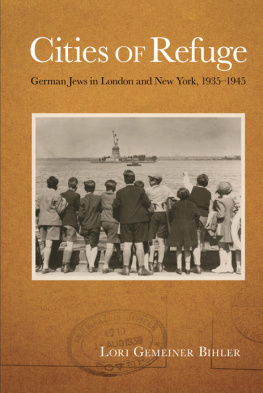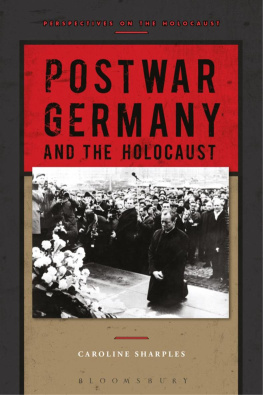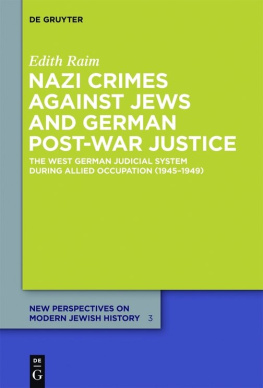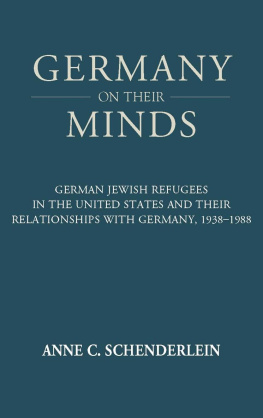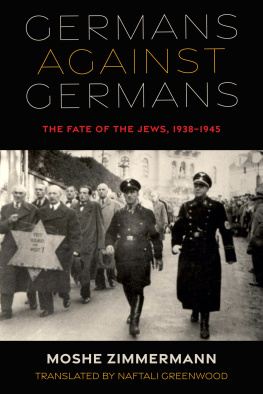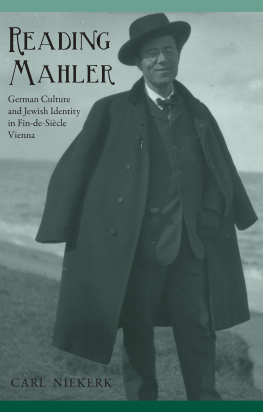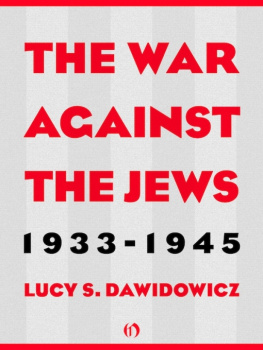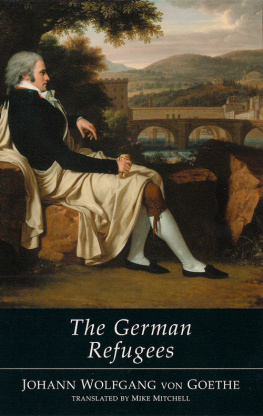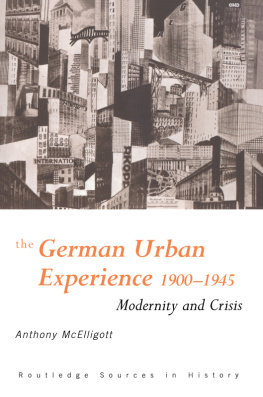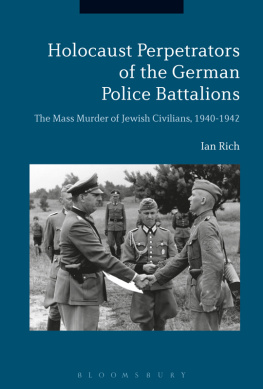Lori Gemeiner Bihler - Cities of Refuge: German Jews in London and New York, 1935-1945
Here you can read online Lori Gemeiner Bihler - Cities of Refuge: German Jews in London and New York, 1935-1945 full text of the book (entire story) in english for free. Download pdf and epub, get meaning, cover and reviews about this ebook. year: 2018, publisher: State University of New York Press, genre: Politics. Description of the work, (preface) as well as reviews are available. Best literature library LitArk.com created for fans of good reading and offers a wide selection of genres:
Romance novel
Science fiction
Adventure
Detective
Science
History
Home and family
Prose
Art
Politics
Computer
Non-fiction
Religion
Business
Children
Humor
Choose a favorite category and find really read worthwhile books. Enjoy immersion in the world of imagination, feel the emotions of the characters or learn something new for yourself, make an fascinating discovery.
- Book:Cities of Refuge: German Jews in London and New York, 1935-1945
- Author:
- Publisher:State University of New York Press
- Genre:
- Year:2018
- Rating:3 / 5
- Favourites:Add to favourites
- Your mark:
- 60
- 1
- 2
- 3
- 4
- 5
Cities of Refuge: German Jews in London and New York, 1935-1945: summary, description and annotation
We offer to read an annotation, description, summary or preface (depends on what the author of the book "Cities of Refuge: German Jews in London and New York, 1935-1945" wrote himself). If you haven't found the necessary information about the book — write in the comments, we will try to find it.
Cities of Refuge: German Jews in London and New York, 1935-1945 — read online for free the complete book (whole text) full work
Below is the text of the book, divided by pages. System saving the place of the last page read, allows you to conveniently read the book "Cities of Refuge: German Jews in London and New York, 1935-1945" online for free, without having to search again every time where you left off. Put a bookmark, and you can go to the page where you finished reading at any time.
Font size:
Interval:
Bookmark:

Cities of Refuge
Cities of Refuge
German Jews in London and New York, 19351945
L ORI G EMEINER B IHLER

Cover photo: United States Holocaust Memorial Museum, courtesy of Steven Pressman/PerlePress Productions
Published by State University of New York Press, Albany
2018 State University of New York
All rights reserved
Printed in the United States of America
No part of this book may be used or reproduced in any manner whatsoever without written permission. No part of this book may be stored in a retrieval system or transmitted in any form or by any means including electronic, electrostatic, magnetic tape, mechanical, photocopying, recording, or otherwise without the prior permission in writing of the publisher.
For information, contact State University of New York Press, Albany, NY
www.sunypress.edu
Library of Congress Cataloging-in-Publication Data
Names: Bihler, Lori Gemeiner, [date].
Title: Cities of refuge : German Jews in London and New York, 19351945 / Lori Gemeiner Bihler.
Description: Albany : State University of New York Press, [2018] | Includes bibliographical references and index.
Identifiers: LCCN 2017018232 (print) | LCCN 2017019431 (ebook) | ISBN 9781438468891 (ebook) | ISBN 9781438468877 (hardcover : alk. paper)
Subjects: LCSH: JewsEnglandLondonHistory20th century. | Jews, GermanEnglandLondonHistory20th century. | Jews, GermanNew York (State)New YorkHistory20th century. | Jews, GermanEnglandLondonSocial life and customs. | Jews, GermanNew York (State)New YorkSocial life and customs. | Jewish refugeesEnglandHistory20th century. | Jewish refugeesNew York (State)History20th century. | London (England)Ethnic relations. | New York (N.Y.)Ethnic relations.
Classification: LCC DS135.E55 (ebook) | LCC DS135.E55 L6626 2018 (print) | DDC 305.892/4042109043dc23
LC record available at https://lccn.loc.gov/2017018232
10 9 8 7 6 5 4 3 2 1
Contents
Illustrations
Tables
Maps
Images
Abbreviations
| AJR | Association of Jewish Refugees |
| CGJS | Centre for German-Jewish Studies, University of Sussex |
| FDKB | Free German Culture League ( Freier Deutscher Kulturbund ) |
| HIAS | Hebrew Sheltering Immigrant Aid Society |
| LBI NY | Leo Baeck Institute, New York |
Preface
A s I BEGAN RESEARCH FOR THIS BOOK , I discovered that former German Jewish refugees on both sides of the Atlantic had specific assumptions about their counterparts experiences. I was told repeatedly in London that New York German Jews became immediately American or immigration was just part of the history of New York. Likewise, when I visited New York, and spoke with former refugees about German Jews in London, many presumed the experience of refugees in London was similar to their own. Such perceptions, true or false, were also reflected in academic works on German Jewish migration to Great Britain, Israel, and the United States. For example, Steven Lowenstein wrote in Frankfurt on the Hudson: The German-Jewish Community of Washington Heights , Most scholars view the integration process in the United States as easier, and more thoroughgoing than was the case in Israel or Great Britain. In England, there was a dominant ethnic group. One did not become English; one was born English. America today permits a much wider pluralism than do either Britain or Israel.
I have determined a need to reexamine these assumptions through a comparative analysis of refugee experience in each country. No work has been undertaken to date that systematically contrasts German Jewish refugee communities in the United States and Great Britain. This book challenges the widely held notion that immigrants integrated into American society because they were the recipients of a greater tradition of tolerance and diversity. It explores the concept of New York and London as cities of refuge, in the actual and not the biblical sense, and allows us to look beyond national mythologies to explain the differences in refugee experience in each city. Drawing on a wide range of published and unpublished sources, this work examines why Jewish refugees in London adopted local ways and customs more quickly than those in New York, yet identified less as British during this period than their counterparts in the United States did as American. Given that both groups of refugees derived from the same diverse yet distinct German Jewish community in Germany, the conclusions reached in this specific historical investigation have implications for the more general understanding of processes of migration and identity negotiation, not only for the Jewish Diaspora, but also for other displaced ethnic groups.
In planning this book, I drew from a relatively limited body of work of comparative migration histories, including Samuel Bailys Immigrants in the Lands of Promise: Italians in Buenos Aires and New York City, 1870 to 1914 , which provided a structural model for the presentation of my findings. As scholars of immigration history, it is vital that our understanding of historical context and its relation to migration today allows us to actively contribute as historians to the dynamic field of migration studies.
Many people helped and inspired me during the writing of this book. I would like to offer my special thanks to several of them. First, I would like to recognize Kristine Wern of the Jewish Museum of Frankfurt for her early encouragement, assistance, and friendship. Long discussions with Kathleen Fish helped me focus my thoughts and begin the writing process. I am also appreciative of Pauline Von Hellerman, Andrea Hammel, Deborah Schultz, Lisa Silverman, Cathy Gelbin, and Polly Beals for lending an ear and allowing me to formulate my ideas aloud with them in the early stages of this work.
Sincere thanks are especially due to the archivists and staff at various institutes who provided practical support and pointed me in the direction of valuable sources. I am particularly appreciative of the assistance of Marie Luise Hahn of the Exilarchiv at the German National Library in Frankfurt, Diane Spielman and the amazing archivists at the Centre for Jewish History in New York, Karen Robson at the Parkes Institute at Southampton University, and Samira Teutenberg, formerly at the Centre for German-Jewish Studies, University of Sussex. The librarians and archivists at the Imperial War Museum, the Wiener Library, and the New York Public Library were also especially helpful.
This research would not have been possible without the consideration and support of the following organizations: the Leo Baeck Institute, Deutscher Akademischer Austauschdienst (German Academic Exchange Service or DAAD), the Anglo-Jewish Association, the Ian Karten Trust, the Jewish Federation of Greater New Haven, the University of Sussex Chancellors International Research Scholarship, and the Centre for German-Jewish Studies. I am especially appreciative of the generosity and kindness of Lilo and Gerry Leeds and to all of the individuals who shared their personal and sometimes painful memories with me in interviews.
I would also like to thank Marion Kaplan, and the late Ruth Gay and Julius Carlebach for their insightful suggestions, advice, and guidance early in my research. I thank Professor Edward Timms, my dissertation advisor, for his patience, encouragement, and belief in my work from the beginning. This book would not have been possible without his support. I very much appreciate the suggestions made by my examiners Professors Tony Kushner and Paul Betts. They have greatly informed this manuscript. My copy editor, Allison Jones, has been extremely patient and thorough. Many thanks go to Allison Greif Rentschler, Moni Beck, Miriam Reumann, and Tara Botelho for reading through various versions of this text. Their friendship and suggestions have been greatly appreciated.
Font size:
Interval:
Bookmark:
Similar books «Cities of Refuge: German Jews in London and New York, 1935-1945»
Look at similar books to Cities of Refuge: German Jews in London and New York, 1935-1945. We have selected literature similar in name and meaning in the hope of providing readers with more options to find new, interesting, not yet read works.
Discussion, reviews of the book Cities of Refuge: German Jews in London and New York, 1935-1945 and just readers' own opinions. Leave your comments, write what you think about the work, its meaning or the main characters. Specify what exactly you liked and what you didn't like, and why you think so.

